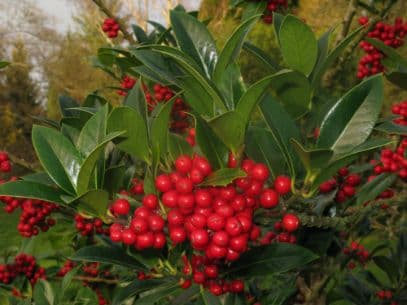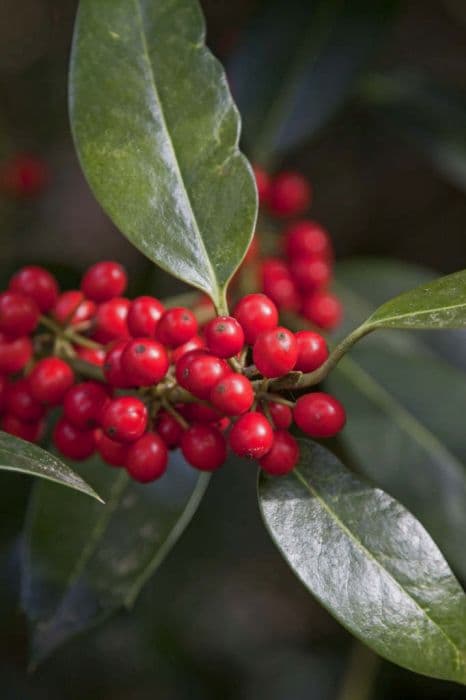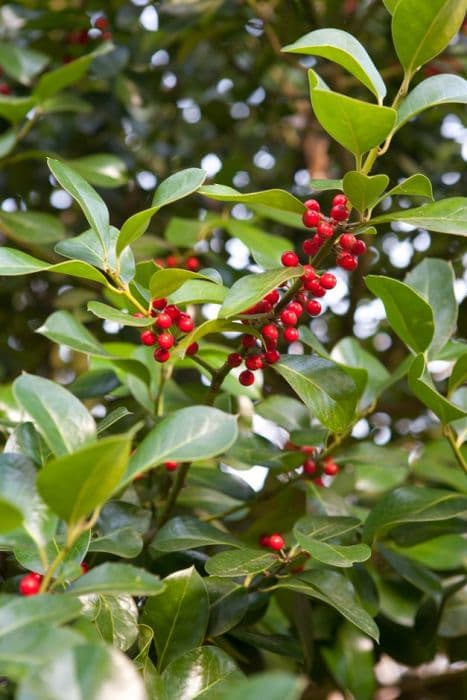Chestnut Leaf Holly Ilex × koehneana 'Chestnut Leaf' (f)

ABOUT
The Ilex × koehneana 'Chestnut Leaf', commonly known as the "Chestnut Leaf Holly," is a visually striking plant that features a distinctive leaf shape reminiscent of a chestnut tree. The leaves are deep green with a glossy sheen, presenting an attractive, dense foliage. Each leaf is quite large and boasts a unique shape with a series of pronounced spines along the edges, giving it a slightly serrated look. In comparison to other hollies, the leaves of the 'Chestnut Leaf' variety are more elongated and have a pointed tip, which adds to the plant's overall elegant and robust appearance. Throughout the year, the foliage maintains its lush green color, making it an excellent choice for gardeners seeking to create an evergreen backdrop or hedge. During the blooming season, the 'Chestnut Leaf' holly produces inconspicuous white flowers that may be difficult to spot against the dense foliage, yet they add a subtle charm upon closer inspection. Following the flowering period, the plant bears attractive red berries that stand out vividly against the dark leaves. These berries not only enhance the visual appeal of the plant but also serve as a food source for various birds and wildlife. The contrast between the red berries and the green leaves is particularly striking in the colder months, providing a much-appreciated burst of color in the landscape. Overall, the physical appearance of the 'Chestnut Leaf' holly is one of classic elegance and year-round beauty, with its richly colored foliage, spiny leaves, and vibrant berries. It makes a valuable addition to gardens and landscapes, offering both visual interest and natural charm.
About this plant
 Names
NamesSynonyms
Koehne Holly, Chestnut Leaf Holly
Common names
Ilex × koehneana 'Chestnut Leaf'
 Toxicity
ToxicityTo humans
The Chestnut Leaf Holly is not commonly reported as highly toxic to humans. However, as with many members of the Ilex genus, the berries may cause gastrointestinal upset if ingested in large quantities. Symptoms of such ingestion could include nausea, vomiting, diarrhea, and abdominal pain.
To pets
The Chestnut Leaf Holly can be toxic to pets, particularly dogs and cats, if ingested. The primary concern is the plant's berries, which contain saponins and can cause gastrointestinal upset. Symptoms of poisoning in pets may include vomiting, diarrhea, drooling, and loss of appetite. In severe cases or when large amounts are ingested, more serious symptoms such as lethargy, dehydration, and drowsiness could occur.
 Characteristics
CharacteristicsLife cycle
Perennials
Foliage type
Evergreen
Color of leaves
Green
Flower color
White
Height
6-10 feet (1.8-3 meters)
Spread
6-10 feet (1.8-3 meters)
Plant type
Shrub
Hardiness zones
6-9
Native area
Cultivar
Benefits
 General Benefits
General Benefits- Landscape Aesthetics: The Ilex × koehneana 'Chestnut Leaf' is known for its attractive foliage and shape, enhancing garden design.
- Privacy Screen: It can serve as a natural privacy barrier when planted in rows or hedges.
- Habitat for Wildlife: The plant provides shelter and berries that serve as a food source for birds and small mammals.
- Low Maintenance: Once established, it requires minimal care, making it a suitable choice for busy gardeners.
- Drought Tolerance: It is relatively tolerant of dry conditions, reducing the need for frequent watering.
- Adaptability: The plant is adaptable to a variety of soils, making it an optimal choice for different garden settings.
 Medical Properties
Medical PropertiesThis plant is not used for medical purposes.
 Air-purifying Qualities
Air-purifying QualitiesThis plant is not specifically known for air purifying qualities.
 Other Uses
Other Uses- Wildlife Habitat: The dense foliage of the Chestnut Leaf Holly provides shelter and nesting sites for birds and other small wildlife.
- Privacy Screen: Planted in rows or groups, this holly variety can form an effective visual barrier, increasing privacy for homeowners.
- Topiary: With its ability to withstand pruning, 'Chestnut Leaf' Holly can be shaped into various topiary forms for decorative landscapes.
- Windbreak: The robust growth can shield gardens and properties from strong winds when planted as a hedgerow.
- Erosion Control: The extensive root system helps to stabilize soil on slopes and prevent erosion.
- Culinary Decoration: The bright red berries, when not consumed, can be used as ornamental decorations in festive dishes during the holiday season.
- Dye Production: Parts of the plant could potentially be used to create natural dyes for fabric or art purposes.
- Woodworking Projects: The wood of the 'Chestnut Leaf' Holly, like other hollies, may be used in small woodworking projects or for making furniture inlays.
- Photography Backdrop: The plant can serve as a photogenic backdrop for outdoor photography due to its dense and glossy foliage.
- Cultural Symbol: As a type of holly, it can be integrated into gardens and landscapes that seek to evoke traditional or historical themes associated with hollies.
Interesting Facts
 Feng Shui
Feng ShuiThe plant Chestnut Leaf Holly is not used in Feng Shui practice.
 Zodiac Sign Compitability
Zodiac Sign CompitabilityThe plant Chestnut Leaf Holly is not used in astrology practice.
 Plant Symbolism
Plant Symbolism- Protection: Ilex, commonly known as holly, has historically been a symbol of protection. People believed that planting holly around their homes could ward off evil spirits and negative energies.
- Foresight: Holly's ability to survive and even thrive in the winter months made it a symbol of foresight and planning, as it embodies the idea of preparing for and enduring adverse conditions.
- Hope: The evergreen nature of holly represents immortality and hope, suggesting that life continues and thrives even in the harshest conditions, serving as a reminder of enduring vitality.
- Goodwill: Holly is often associated with Christmas, a time of goodwill and friendship. As a decoration, it symbolizes an invitation for good spirits and cheer into the home during festive seasons.
 Water
WaterThe Chestnut Leaf Holly should be watered deeply once or twice a week, allowing the soil to dry out slightly between waterings. During the growing season, in spring and summer, it might require more frequent watering, especially in warmer climates or during droughts. It's recommended to provide about one to two inches of water weekly, which translates to approximately 0.62 to 1.25 gallons for an average-sized plant. Reduce watering in the fall and further in winter when the plant's water requirements decrease.
 Light
LightThe Chestnut Leaf Holly prefers full sun to partial shade. The ideal spot would provide it with at least 4 to 6 hours of direct sunlight per day, while also offering some shelter from the harsh afternoon sun, especially in hotter climates. If the plant is grown indoors, it should be placed near a window where it can receive ample bright, indirect sunlight.
 Temperature
TemperatureThe Chestnut Leaf Holly is hardy and can tolerate a temperature range from about 20°F in the winter to 90°F in the summer. Ideal growth is observed when the temperature remains between 50°F and 70°F. It's important to protect the plant from drastic temperature swings and ensure it's positioned in a location where it won't experience extreme cold or heat throughout the year.
 Pruning
PruningPruning the Chestnut Leaf Holly helps maintain its shape and encourages bushier growth. It should be pruned in the late winter or early spring before the onset of new growth. Remove any dead, damaged, or diseased branches, and trim back to maintain the desired shape and size. Pruning may also be necessary after a growth spurt in summer to keep the plant looking tidy.
 Cleaning
CleaningAs needed
 Soil
SoilThe Chestnut Leaf Holly thrives best in well-draining, acidic soil with a pH between 5.0 and 6.0. A suitable soil mix can be created by combining garden soil, peat moss or compost, and perlite or coarse sand, which helps with drainage and aeration. Regular mulching can help maintain soil moisture and acidity.
 Repotting
RepottingThe Chestnut Leaf Holly should be repotted every 2 to 3 years, preferably in spring before the new growth starts. This timeframe allows the plant to establish its root system and accustom to the new container before facing stress from growth or environmental changes.
 Humidity & Misting
Humidity & MistingThe Chestnut Leaf Holly prefers a moderate humidity level, usually between 40% to 60%, which is often the average indoor humidity level. It can tolerate some deviation from this range, but extreme dryness should be avoided.
 Suitable locations
Suitable locationsIndoor
Place in bright, indirect light and water when topsoil is dry.
Outdoor
Plant in partial shade to full sun, and shelter from strong winds.
Hardiness zone
6-9 USDA
 Life cycle
Life cycleIlex × koehneana 'Chestnut Leaf', commonly known as the Koehne Holly, begins its life cycle with seed germination, where environmental conditions trigger the growth of a new plant from a seed. This stage is followed by the juvenile phase, where the seedling develops into a young plant with a basic root system and foliage, gradually maturing as it accumulates resources. As it enters the adult phase, the Koehne Holly begins to produce flowers, typically small and white, which are pollinated by insects or wind, leading to the production of berries that contain seeds for the next generation. The adult plant continues a cycle of growth and dormancy, with periods of active growth in the spring and summer and dormancy in the fall and winter. Over several years, the Koehne Holly reaches its full size and maturity, developing into a dense shrub with glossy, spiny leaves resembling those of a chestnut. The life span of this holly can extend over many years, with the plant continuing to reproduce and contribute to the ecosystem until it experiences senescence and eventually dies.
 Propogation
PropogationPropogation time
Early spring
Propogation: The Ilex × koehneana 'Chestnut Leaf', commonly known as the Chestnut Leaf Holly, is typically propagated through semi-hardwood cuttings. This method is most successful when carried out during the late summer to early fall, when the current year's growth has matured enough but has not yet become woody. To propagate, take cuttings of about 4 to 6 inches (10 to 15 centimeters) in length, ensuring each cutting has several leaves. Dip the cut end in rooting hormone to enhance root development, then insert the cutting into a pot filled with a well-draining rooting medium such as a mix of peat and perlite or sand. The cutting should be kept moist and placed in indirect light until rooting occurs, usually within a few weeks. A plastic bag or a propagator can help maintain humidity around the cutting, which is beneficial for root formation.









